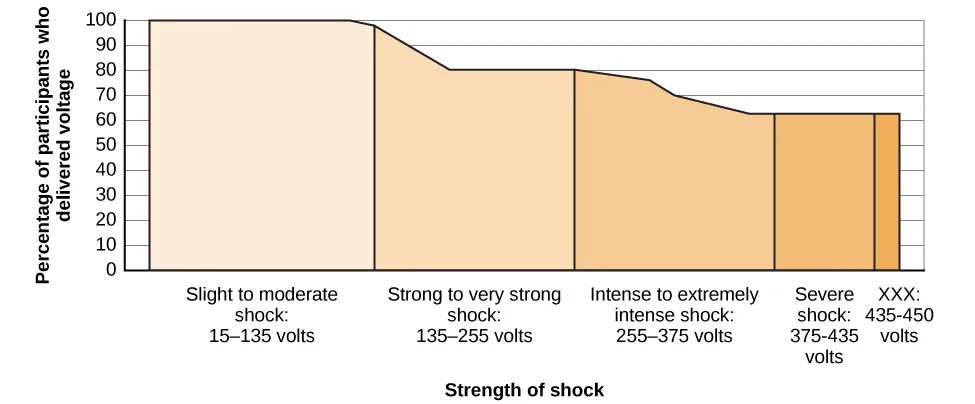Conformity, Compliance and Obediance
Learning Objectives
By the end of this section, you will be able to:
- Explain the Asch effect
- Define conformity and types of social influence
- Describe Stanley Milgram’s experiment and its implications
- Define groupthink, social facilitation, and social loafing
In this section, we discuss additional ways in which people influence others. The topics of conformity, social influence, obedience, and group processes demonstrate the power of the social situation to change our thoughts, feelings, and behaviours. We begin this section with a discussion of a famous social psychology experiment that demonstrated how susceptible humans are to outside social pressures.
Conformity
Solomon Asch conducted several experiments in the 1950s to determine how people are affected by the thoughts and behaviours of other people. In one study, a group of participants was shown a series of printed line segments of different lengths: a, b, and c (Figure 9.18). Participants were then shown a fourth line segment: x. They were asked to identify which line segment from the first group (a, b, or c) most closely resembled the fourth line segment in length.

Each group of participants had only one true, naïve subject. The remaining members of the group were confederates of the researcher. A confederate is a person who is aware of the experiment and works for the researcher. Confederates are used to manipulate social situations as part of the research design, and the true, naïve participants believe that confederates are, like them, uninformed participants in the experiment. In Asch’s study, the confederates identified a line segment that was obviously shorter than the target line—a wrong answer. The naïve participant then had to identify aloud the line segment that best matched the target line segment.
How often do you think the true participant aligned with the confederates’ response? That is, how often do you think the group influenced the participant, and the participant gave the wrong answer? Asch (1955) found that 76% of participants conformed to group pressure at least once by indicating the incorrect line. Conformity is the change in a person’s behaviour to go along with the group, even if he does not agree with the group. Why would people give the wrong answer? What factors would increase or decrease someone giving in or conforming to group pressure?
The Asch effect is the influence of the group majority on an individual’s judgment.
What factors make a person more likely to yield to group pressure? Research shows that the size of the majority, the presence of another dissenter, and the public or relatively private nature of responses are key influences on conformity.
- The size of the majority: The greater the number of people in the majority, the more likely an individual will conform. There is, however, an upper limit: a point where adding more members does not increase conformity. In Asch’s study, conformity increased with the number of people in the majority—up to seven individuals. At numbers beyond seven, conformity leveled off and decreased slightly (Asch, 1955).
- The presence of another dissenter: If there is at least one dissenter, conformity rates drop to near zero (Asch, 1955).
- The public or private nature of the responses: When responses are made publicly (in front of others), conformity is more likely; however, when responses are made privately (e.g., writing down the response), conformity is less likely (Deutsch & Gerard, 1955).
The finding that conformity is more likely to occur when responses are public than when they are private is the reason government elections require voting in secret, so we are not coerced by others (Figure 9.19). The Asch effect can be easily seen in children when they have to publicly vote for something. For example, if the teacher asks whether the children would rather have extra recess, no homework, or candy, once a few children vote, the rest will comply and go with the majority. In a different classroom, the majority might vote differently, and most of the children would comply with that majority. When someone’s vote changes if it is made in public versus private, this is known as compliance. Compliance can be a form of conformity. Compliance is going along with a request or demand, even if you do not agree with the request. In Asch’s studies, the participants complied by giving the wrong answers, but privately did not accept that the obvious wrong answers were correct.

Now that you have learned about the Asch line experiments, why do you think the participants conformed? The correct answer to the line segment question was obvious, and it was an easy task. Researchers have categorized the motivation to conform into two types: normative social influence and informational social influence (Deutsch & Gerard, 1955).
In normative social influence, people conform to the group norm to fit in, to feel good, and to be accepted by the group. However, with informational social influence, people conform because they believe the group is competent and has the correct information, particularly when the task or situation is ambiguous. What type of social influence was operating in the Asch conformity studies? Since the line judgment task was unambiguous, participants did not need to rely on the group for information. Instead, participants complied to fit in and avoid ridicule, an instance of normative social influence.
An example of informational social influence may be what to do in an emergency situation. Imagine that you are in a movie theater watching a film and what seems to be smoke comes in the theater from under the emergency exit door. You are not certain that it is smoke—it might be a special effect for the movie, such as a fog machine. When you are uncertain you will tend to look at the behaviour of others in the theater. If other people show concern and get up to leave, you are likely to do the same. However, if others seem unconcerned, you are likely to stay put and continue watching the movie (Figure 9.20).

How would you have behaved if you were a participant in Asch’s study? Many students say they would not conform, that the study is outdated, and that people nowadays are more independent. To some extent this may be true. Research suggests that overall rates of conformity may have reduced since the time of Asch’s research. Furthermore, efforts to replicate Asch’s study have made it clear that many factors determine how likely it is that someone will demonstrate conformity to the group. These factors include the participant’s age, gender, and socio-cultural background (Bond & Smith, 1996; Larsen, 1990; Walker & Andrade, 1996).
Stanley Milgram’s Experiment
Conformity is one effect of the influence of others on our thoughts, feelings, and behaviours. Another form of social influence is obedience to authority. Obedience is the change of an individual’s behaviour to comply with a demand by an authority figure. People often comply with the request because they are concerned about a consequence if they do not comply. To demonstrate this phenomenon, we review another classic social psychology experiment.
Stanley Milgram was a social psychology professor at Yale who was influenced by the trial of Adolf Eichmann, a Nazi war criminal. Eichmann’s defense for the atrocities he committed was that he was “just following orders.” Milgram (1963) wanted to test the validity of this defense, so he designed an experiment and initially recruited 40 men for his experiment. The volunteer participants were led to believe that they were participating in a study to improve learning and memory. The participants were told that they were to teach other students (learners) correct answers to a series of test items. The participants were shown how to use a device that they were told delivered electric shocks of different intensities to the learners. The participants were told to shock the learners if they gave a wrong answer to a test item—that the shock would help them to learn. The participants believed they gave the learners shocks, which increased in 15-volt increments, all the way up to 450 volts. The participants did not know that the learners were confederates and that the confederates did not actually receive shocks.
In response to a string of incorrect answers from the learners, the participants obediently and repeatedly shocked them. The confederate learners cried out for help, begged the participant teachers to stop, and even complained of heart trouble. Yet, when the researcher told the participant-teachers to continue the shock, 65% of the participants continued the shock to the maximum voltage and to the point that the learner became unresponsive (Figure 9.21). What makes someone obey authority to the point of potentially causing serious harm to another person?

Several variations of the original Milgram experiment were conducted to test the boundaries of obedience. When certain features of the situation were changed, participants were less likely to continue to deliver shocks (Milgram, 1965). For example, when the setting of the experiment was moved to an off-campus office building, the percentage of participants who delivered the highest shock dropped to 48%. When the learner was in the same room as the teacher, the highest shock rate dropped to 40%. When the teachers’ and learners’ hands were touching, the highest shock rate dropped to 30%. When the researcher gave the orders by phone, the rate dropped to 23%. These variations show that when the humanity of the person being shocked was increased, obedience decreased. Similarly, when the authority of the experimenter decreased, so did obedience.
This case is still very applicable today. What does a person do if an authority figure orders something done? What if the person believes it is incorrect, or worse, unethical? In a study by Martin and Bull (2008), midwives privately filled out a questionnaire regarding best practices and expectations in delivering a baby. Then, a more senior midwife and supervisor asked the junior midwives to do something they had previously stated they were opposed to. Most of the junior midwives were obedient to authority, going against their own beliefs. Burger (2009) partially replicated this study. He found among a multicultural sample of women and men that their levels of obedience matched Milgram’s research. Doliński et al. (2017) performed a replication of Burger’s work in Poland and controlled for the gender of both participants and learners, and once again, results that were consistent with Milgram’s original work were observed.
Groupthink
When in group settings, we are often influenced by the thoughts, feelings, and behaviours of people around us. Whether it is due to normative or informational social influence, groups have power to influence individuals. Another phenomenon of group conformity is groupthink. Groupthink is the modification of the opinions of members of a group to align with what they believe is the group consensus (Janis, 1972). In group situations, the group often takes action that individuals would not perform outside the group setting because groups make more extreme decisions than individuals do. Moreover, groupthink can hinder opposing trains of thought. This elimination of diverse opinions contributes to faulty decision by the group.
DIG DEEPER: Groupthink in the U.S. Government
There have been several instances of groupthink in the U.S. government. One example occurred when the United States led a small coalition of nations to invade Iraq in March 2003. This invasion occurred because a small group of advisors and former President George W. Bush were convinced that Iraq represented a significant terrorism threat with a large stockpile of weapons of mass destruction at its disposal. Although some of these individuals may have had some doubts about the credibility of the information available to them at the time, in the end, the group arrived at a consensus that Iraq had weapons of mass destruction and represented a significant threat to national security. It later came to light that Iraq did not have weapons of mass destruction, but not until the invasion was well underway. As a result, 6000 American soldiers were killed and many more civilians died. How did the Bush administration arrive at their conclusions? View this video of Colin Powell, 10 years after his famous United Nations speech, discussing the information he had at the time that his decisions were based on. (“CNN Official Interview: Colin Powell now regrets UN speech about WMDs,” 2010).
Do you see evidence of groupthink?
Why does groupthink occur? There are several causes of groupthink, which makes it preventable. When the group is highly cohesive, or has a strong sense of connection, maintaining group harmony may become more important to the group than making sound decisions. If the group leader is directive and makes his opinions known, this may discourage group members from disagreeing with the leader. If the group is isolated from hearing alternative or new viewpoints, groupthink may be more likely. How do you know when groupthink is occurring?
There are several symptoms of groupthink including the following:
- perceiving the group as invulnerable or invincible—believing it can do no wrong
- believing the group is morally correct
- self-censorship by group members, such as withholding information to avoid disrupting the group consensus
- the quashing of dissenting group members’ opinions
- the shielding of the group leader from dissenting views
- perceiving an illusion of unanimity among group members
- holding stereotypes or negative attitudes toward the out-group or others’ with differing viewpoints (Janis, 1972)
Given the causes and symptoms of groupthink, how can it be avoided? There are several strategies that can improve group decision making including seeking outside opinions, voting in private, having the leader withhold position statements until all group members have voiced their views, conducting research on all viewpoints, weighing the costs and benefits of all options, and developing a contingency plan (Janis, 1972; Mitchell & Eckstein, 2009).
Read about Groupthink and how it may have played a role during the pandemic. Dr. Ari Joffe, from the University of Alberta, argues that the presentation of fearful information at the start of the pandemic led to the use of lockdowns, and that lockdowns could be doing more harm then good. Read more at COVID-19: Rethinking the Lockdown Groupthink.
Do you agree with Dr. Joffe’s argument?
Can you provide other examples of how groupthink may have played a role during the pandemic?
Group Polarization
Another phenomenon that occurs within group settings is group polarization. Group polarization (Teger & Pruitt, 1967) is the strengthening of an original group attitude after the discussion of views within a group. That is, if a group initially favors a viewpoint, after discussion the group consensus is likely a stronger endorsement of the viewpoint. Conversely, if the group was initially opposed to a viewpoint, group discussion would likely lead to stronger opposition. Group polarization explains many actions taken by groups that would not be undertaken by individuals. Group polarization can be observed at political conventions, when platforms of the party are supported by individuals who, when not in a group, would decline to support them. Recently, some theorists have argued that group polarization may be partly responsible for the extreme political partisanship that seems ubiquitous in modern society. Given that people can self-select media outlets that are most consistent with their own political views, they are less likely to encounter opposing viewpoints. Over time, this leads to a strengthening of their own perspective and of hostile attitudes and behaviours towards those with different political ideals. Remarkably, political polarization leads to open levels of discrimination that are on par with, or perhaps exceed, racial discrimination (Iyengar & Westwood, 2015). A more everyday example is a group’s discussion of how attractive someone is. Does your opinion change if you find someone attractive, but your friends do not agree? If your friends vociferously agree, might you then find this person even more attractive?
Social traps refer to situations that arise when individuals or groups of individuals behave in ways that are not in their best interest and that may have negative, long-term consequences. However, once established, a social trap is very difficult to escape. For example, following World War II, the United States and the former Soviet Union engaged in a nuclear arms race. While the presence of nuclear weapons is not in either party’s best interest, once the arms race began, each country felt the need to continue producing nuclear weapons to protect itself from the other.
Social Loafing
Imagine you were just assigned a group project with other students whom you barely know. Everyone in your group will get the same grade. Are you the type who will do most of the work, even though the final grade will be shared? Or are you more likely to do less work because you know others will pick up the slack? Social loafing involves a reduction in individual output on tasks where contributions are pooled. Because each individual’s efforts are not evaluated, individuals can become less motivated to perform well. Karau and Williams (1993) and Simms and Nichols (2014) reviewed the research on social loafing and discerned when it was least likely to happen. The researchers noted that social loafing could be alleviated if, among other situations, individuals knew their work would be assessed by a manager (in a workplace setting) or instructor (in a classroom setting), or if a manager or instructor required group members to complete self-evaluations.
The likelihood of social loafing in student work groups increases as the size of the group increases (Shepperd & Taylor, 1999). According to Kamau and Williams (1993), college students were the population most likely to engage in social loafing. Their study also found that women and participants from collectivistic cultures were less likely to engage in social loafing, explaining that their group orientation may account for this.
College students could work around social loafing or “free-riding” by suggesting to their professors use of a flocking method to form groups. Harding (2018) compared groups of students who had self-selected into groups for class to those who had been formed by flocking, which involves assigning students to groups who have similar schedules and motivations. Not only did she find that students reported less “free riding,” but that they also did better in the group assignments compared to those whose groups were self-selected.
Interestingly, the opposite of social loafing occurs when the task is complex and difficult (Bond & Titus, 1983; Geen, 1989). In a group setting, such as the student work group, if your individual performance cannot be evaluated, there is less pressure for you to do well, and thus less anxiety or physiological arousal (Latané, Williams, & Harkens, 1979). This puts you in a relaxed state in which you can perform your best, if you choose (Zajonc, 1965). If the task is a difficult one, many people feel motivated and believe that their group needs their input to do well on a challenging project (Jackson & Williams, 1985).
Deindividuation
Another way that being part of a group can affect behaviour is exhibited in instances in which deindividuation occurs. Deindividuation refers to situations in which a person may feel a sense of anonymity and therefore a reduction in accountability and sense of self when among others. Deindividuation is often pointed to in cases in which mob or riot-like behaviours occur (Zimbardo, 1969), but research on the subject and the role that deindividuation plays in such behaviours has resulted in inconsistent results (as discussed in Granström, Guvå, Hylander, & Rosander, 2009).
Table 9.2 summarizes the types of social influence you have learned about in this chapter.
| Types of Social Influence | |
|---|---|
| Type of Social Influence | Description |
| Conformity | Changing your behaviour to go along with the group even if you do not agree with the group |
| Compliance | Going along with a request or demand |
| Normative social influence | Conformity to a group norm to fit in, feel good, and be accepted by the group |
| Informational social influence | Conformity to a group norm prompted by the belief that the group is competent and has the correct information |
| Obedience | Changing your behaviour to please an authority figure or to avoid aversive consequences |
| Groupthink | Tendency to prioritize group cohesion over critical thinking that might lead to poor decision making; more likely to occur when there is perceived unanimity among the group |
| Group polarization | Strengthening of the original group attitude after discussing views within a group |
| Social facilitation | Improved performance when an audience is watching versus when the individual performs the behaviour alone |
| Social loafing | Exertion of less effort by a person working in a group because individual performance cannot be evaluated separately from the group, thus causing performance decline on easy tasks |
| Deindividuation | Group situation in which a person may feel a sense of anonymity and a resulting reduction in accountability and sense of self |
a person who works with a researcher on an experiment, often acting as a participant in order to deceive real participants
going along with a request or demand, even if you do not agree with the request
people conform to the group norm to fit in, to feel good, and to be accepted by the group
people conform because they believe the group is competent and has the correct information, particularly when the task or situation is ambiguous
the change of an individual’s behaviour to comply with a demand by an authority figure
the strengthening of an original group attitude after the discussion of views within a group
situations that arise when individuals or groups of individuals behave in ways that are not in their best interest and that may have negative, long-term consequences
refers to situations in which a person may feel a sense of anonymity and therefore a reduction in accountability and sense of self when among others

